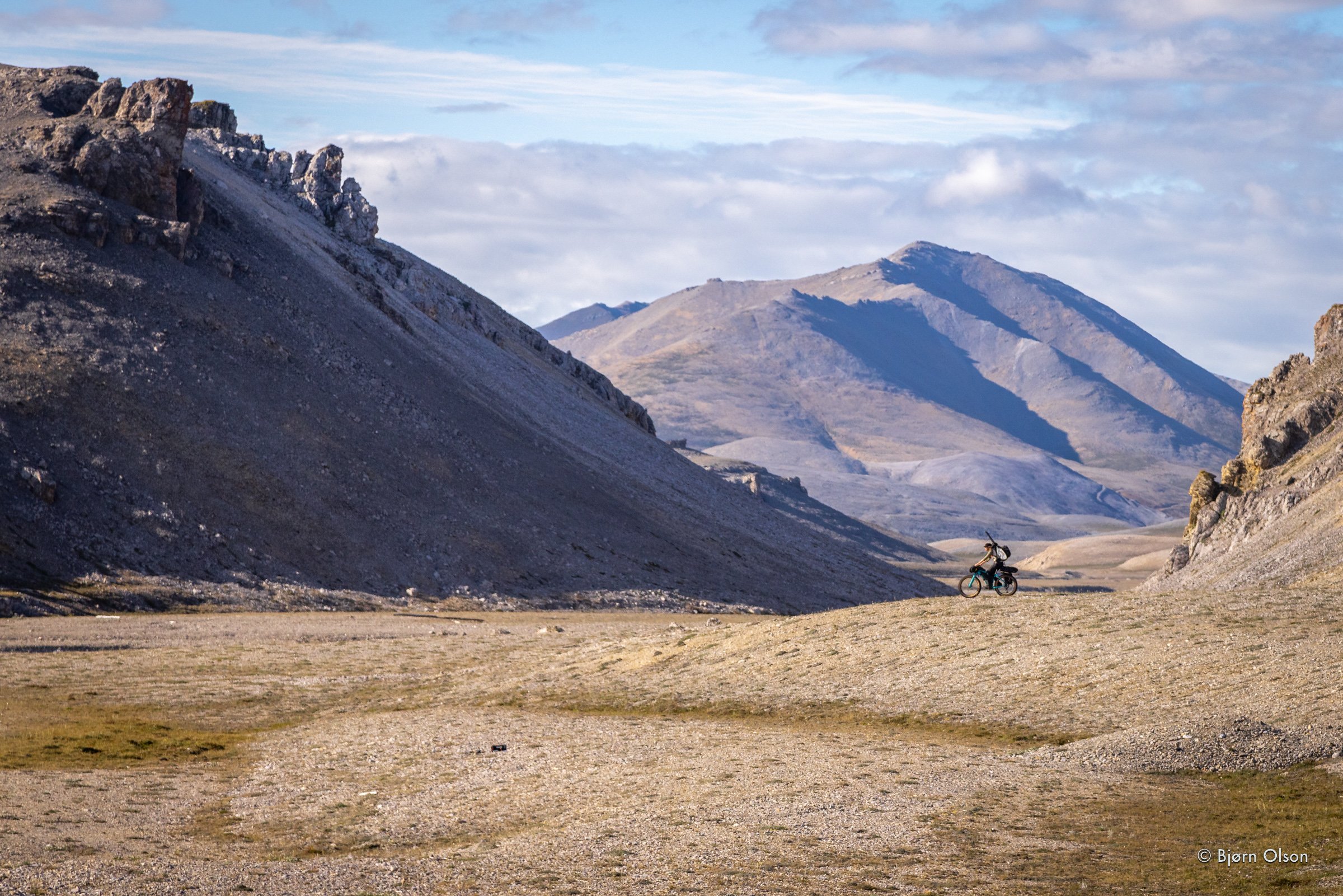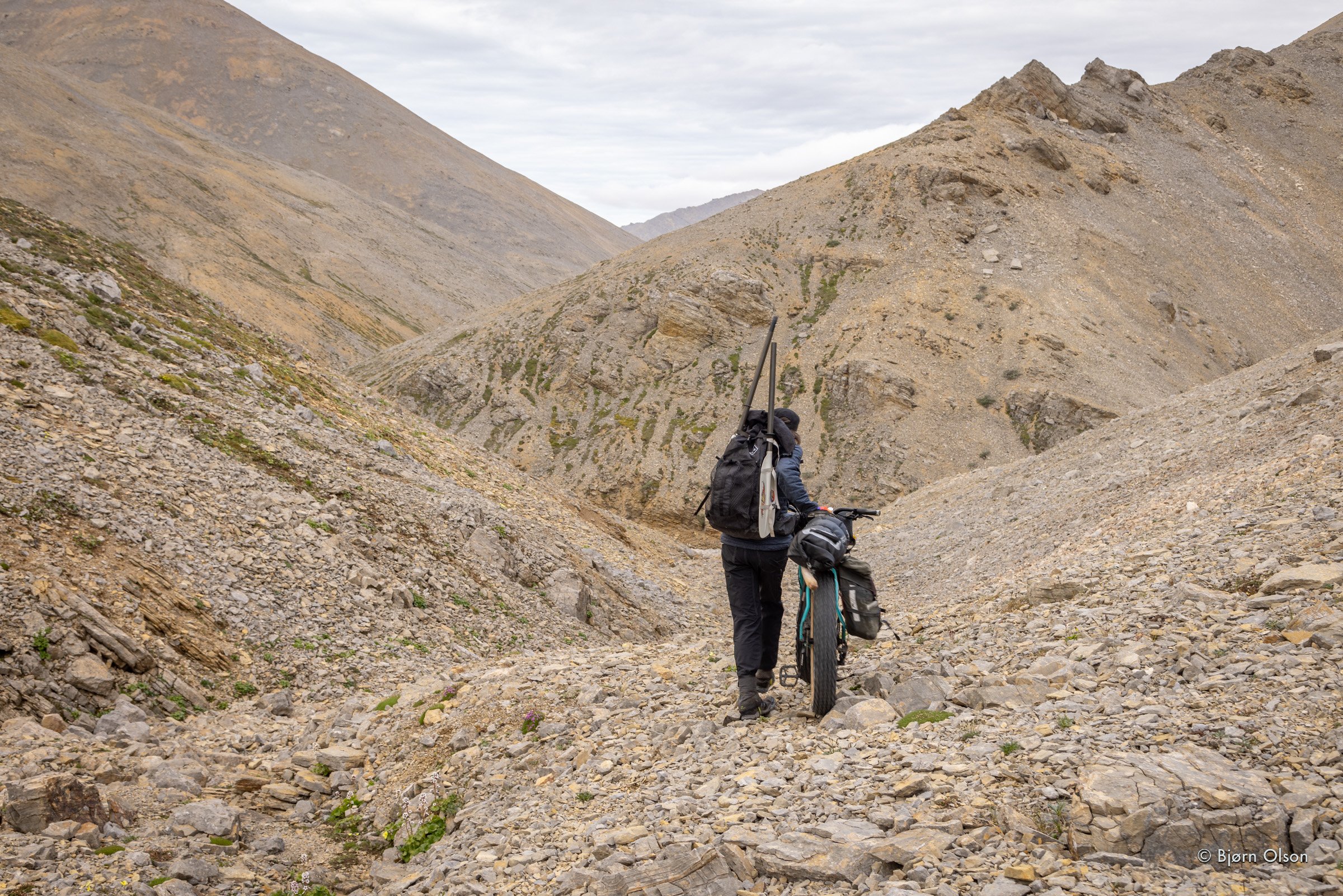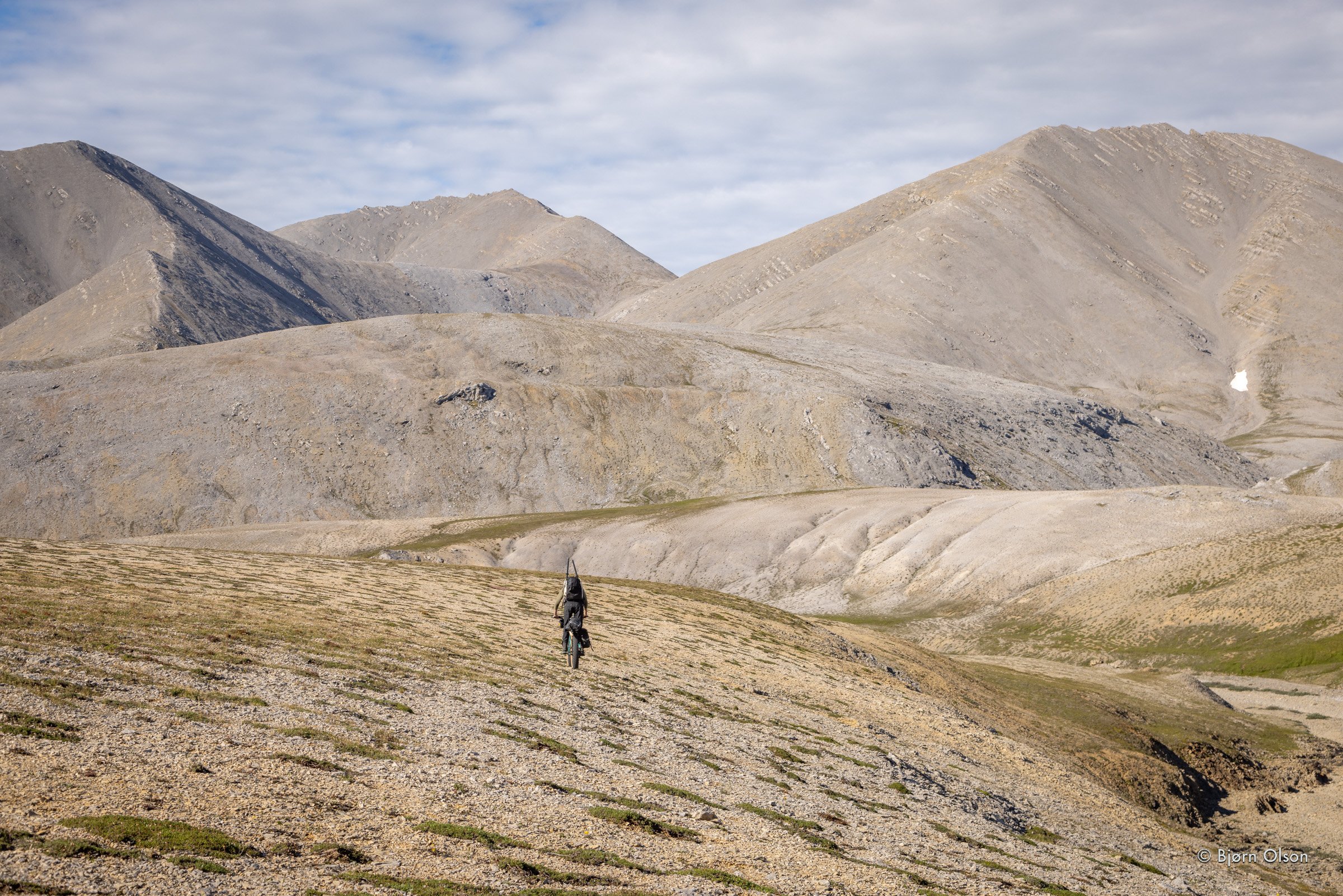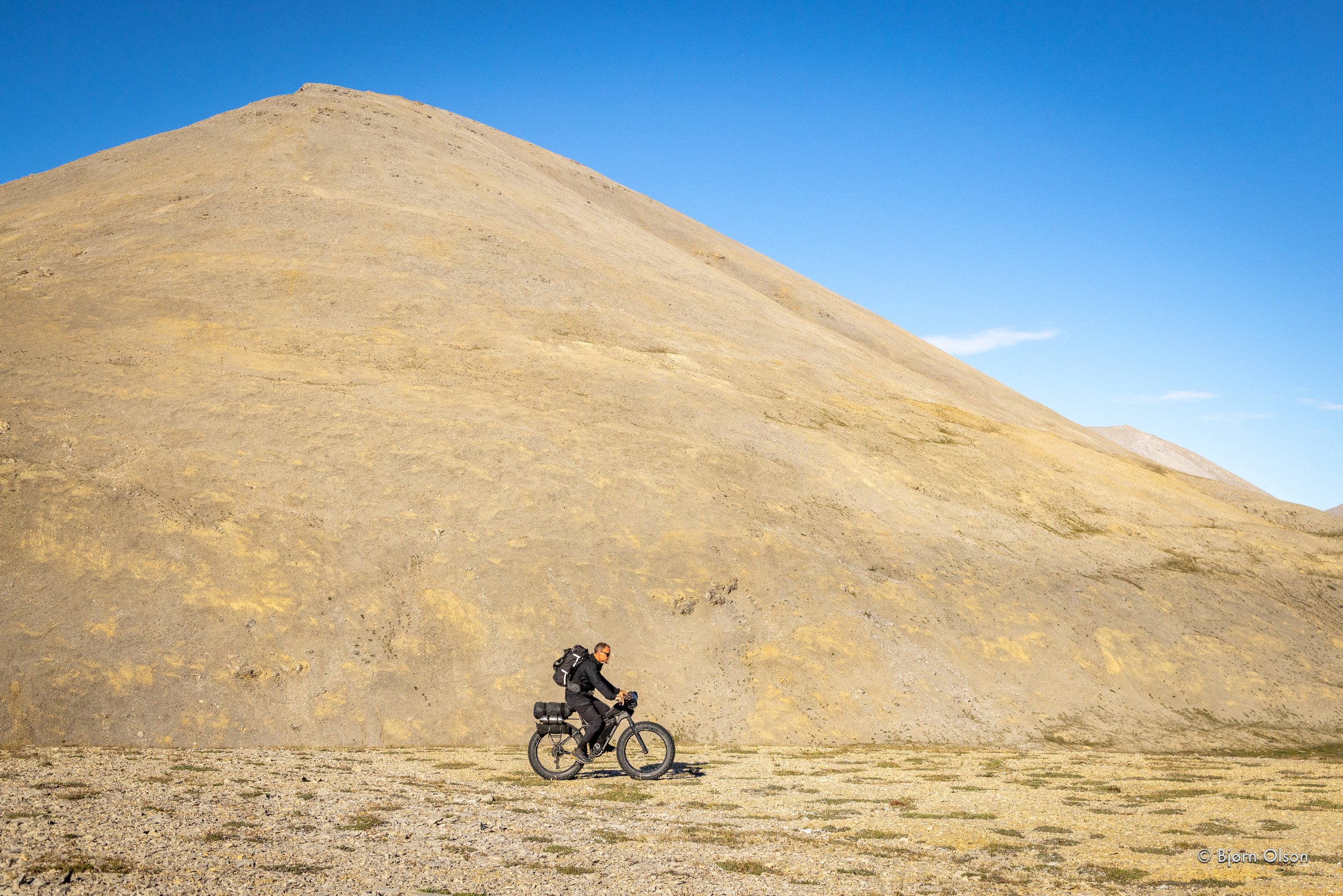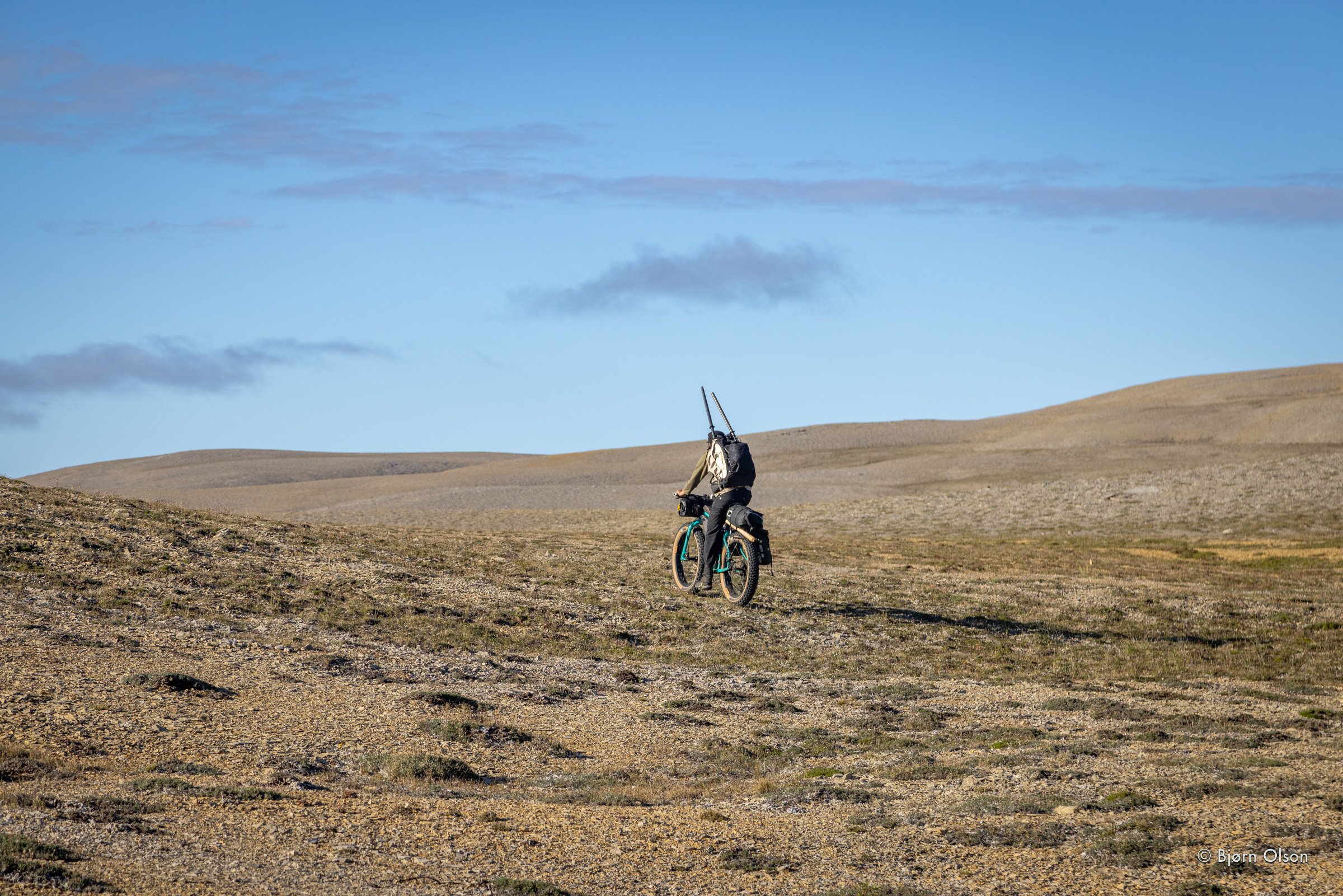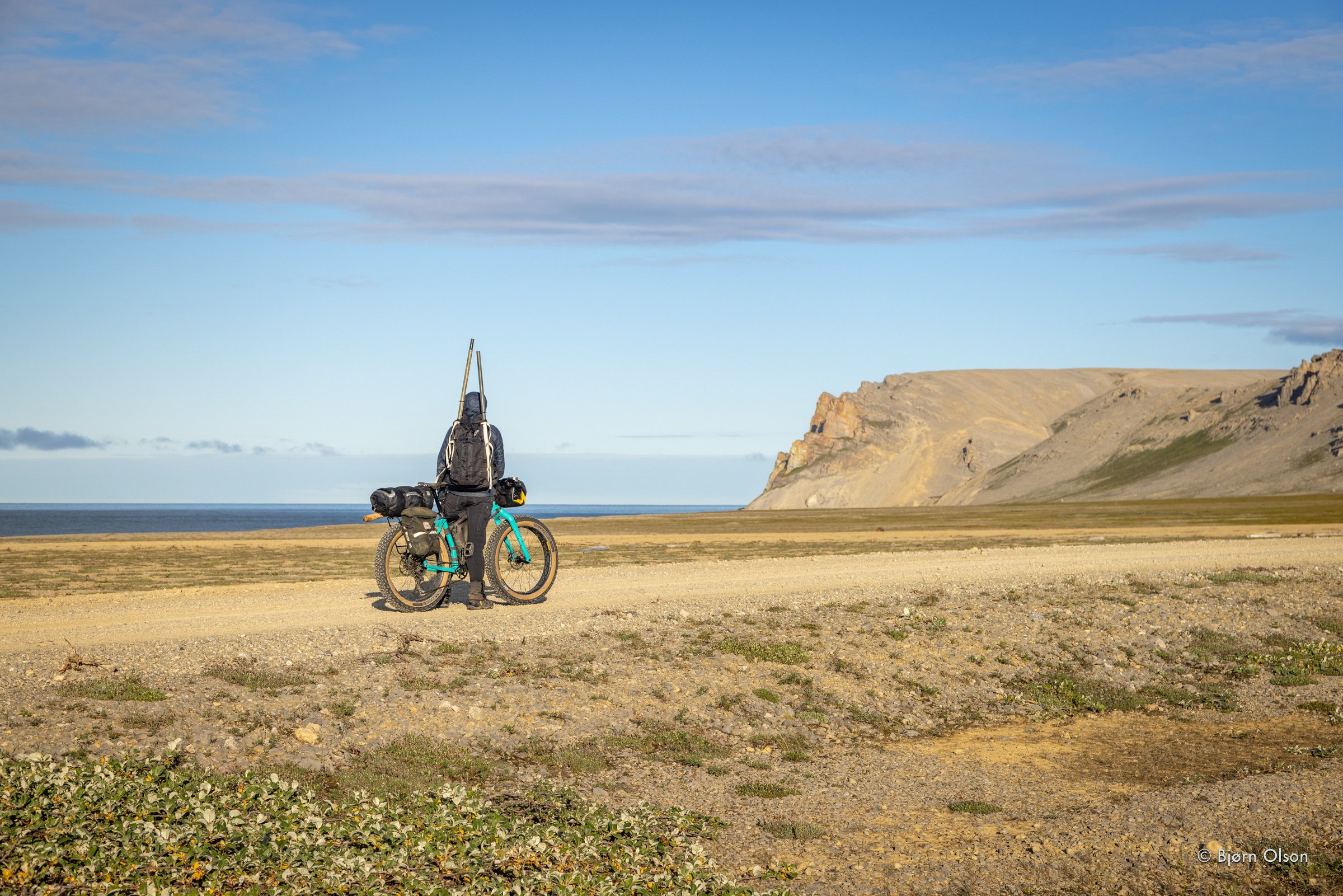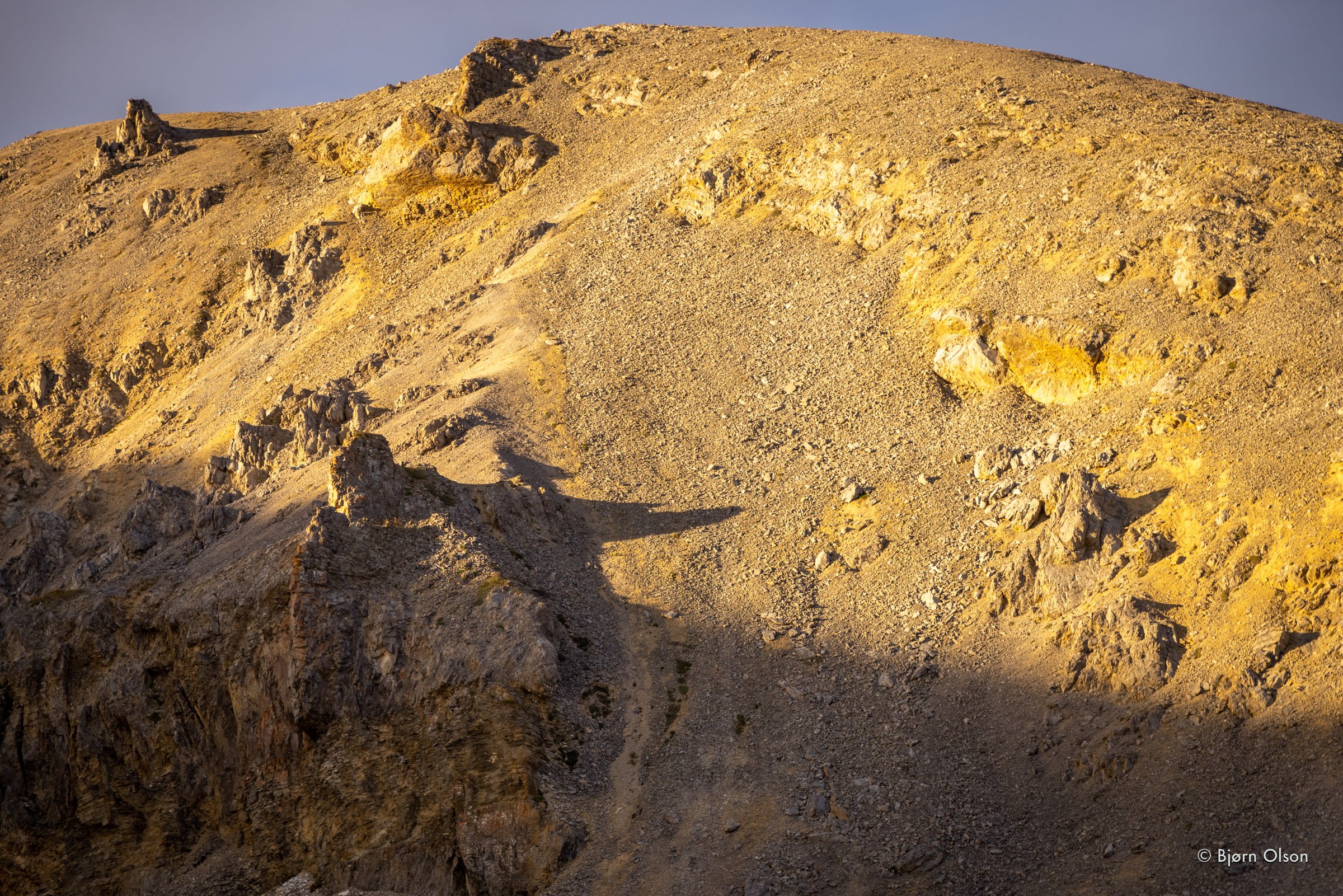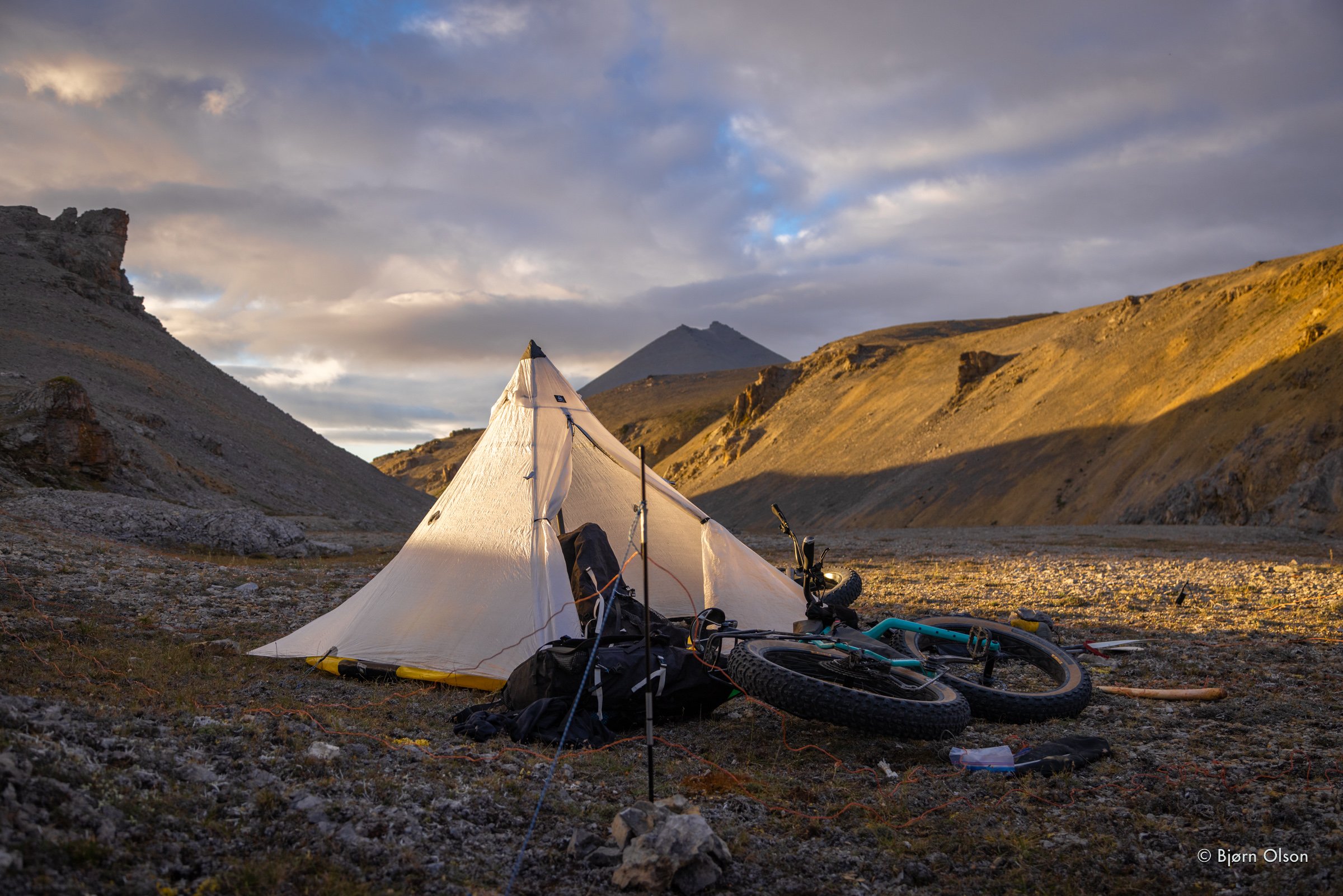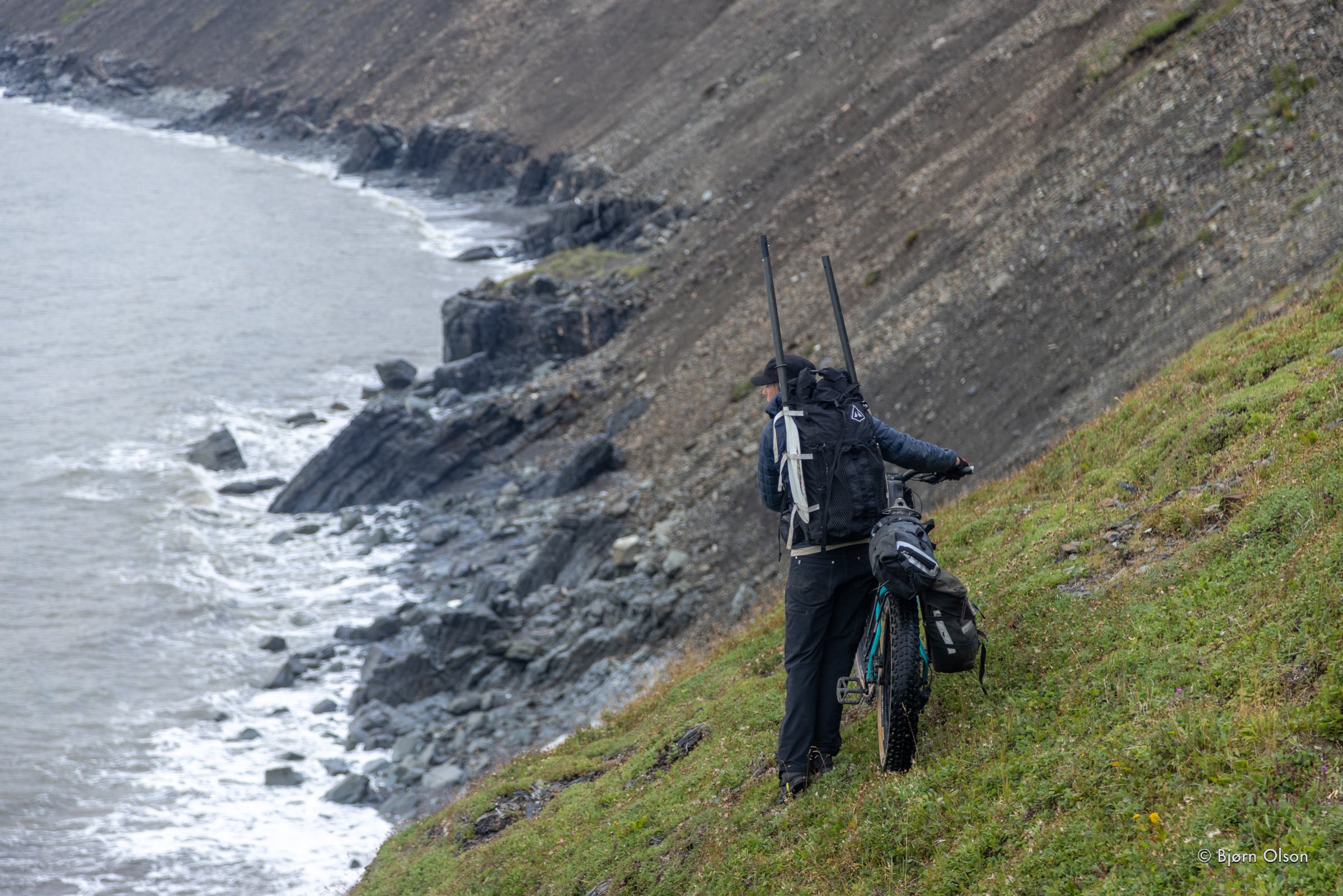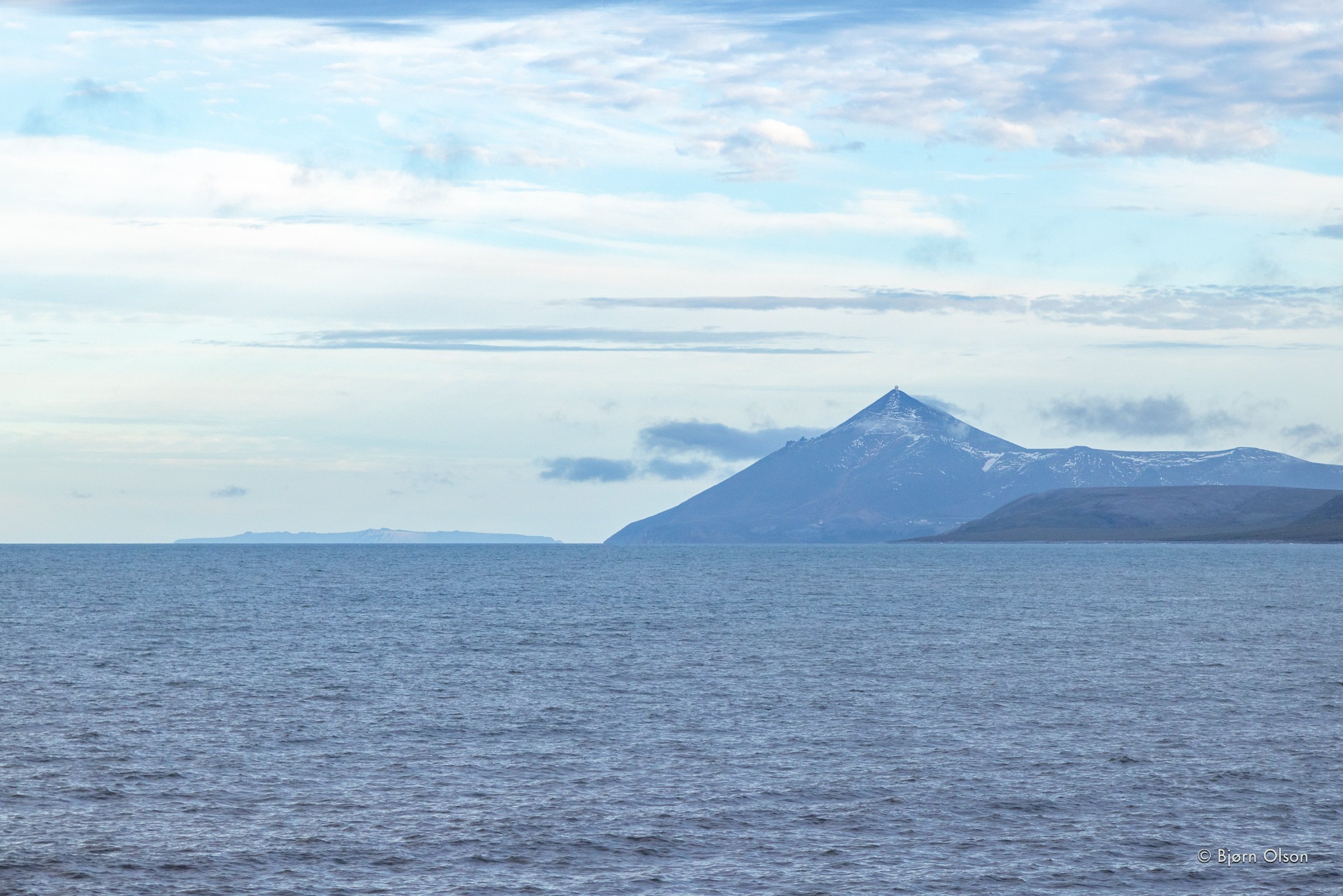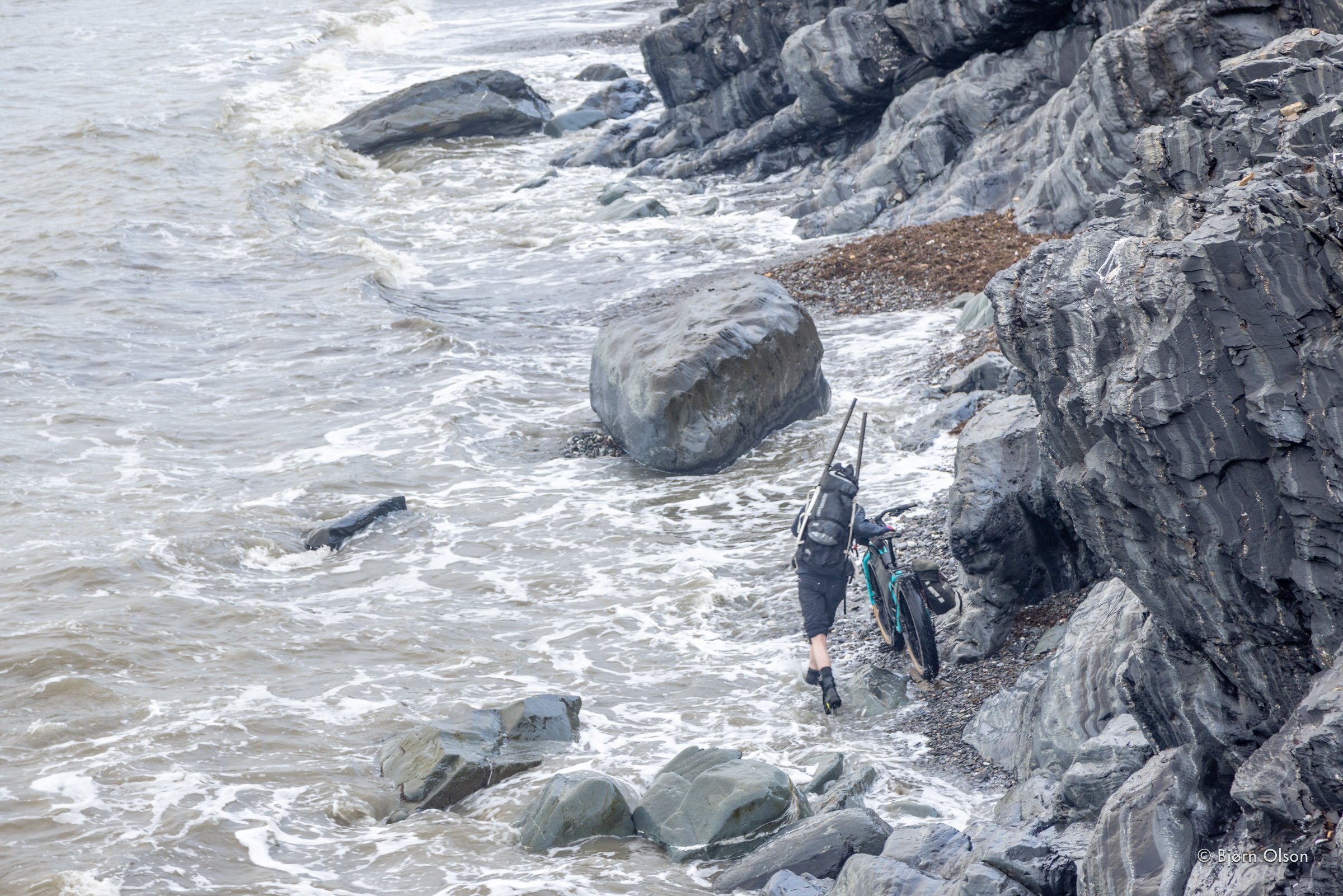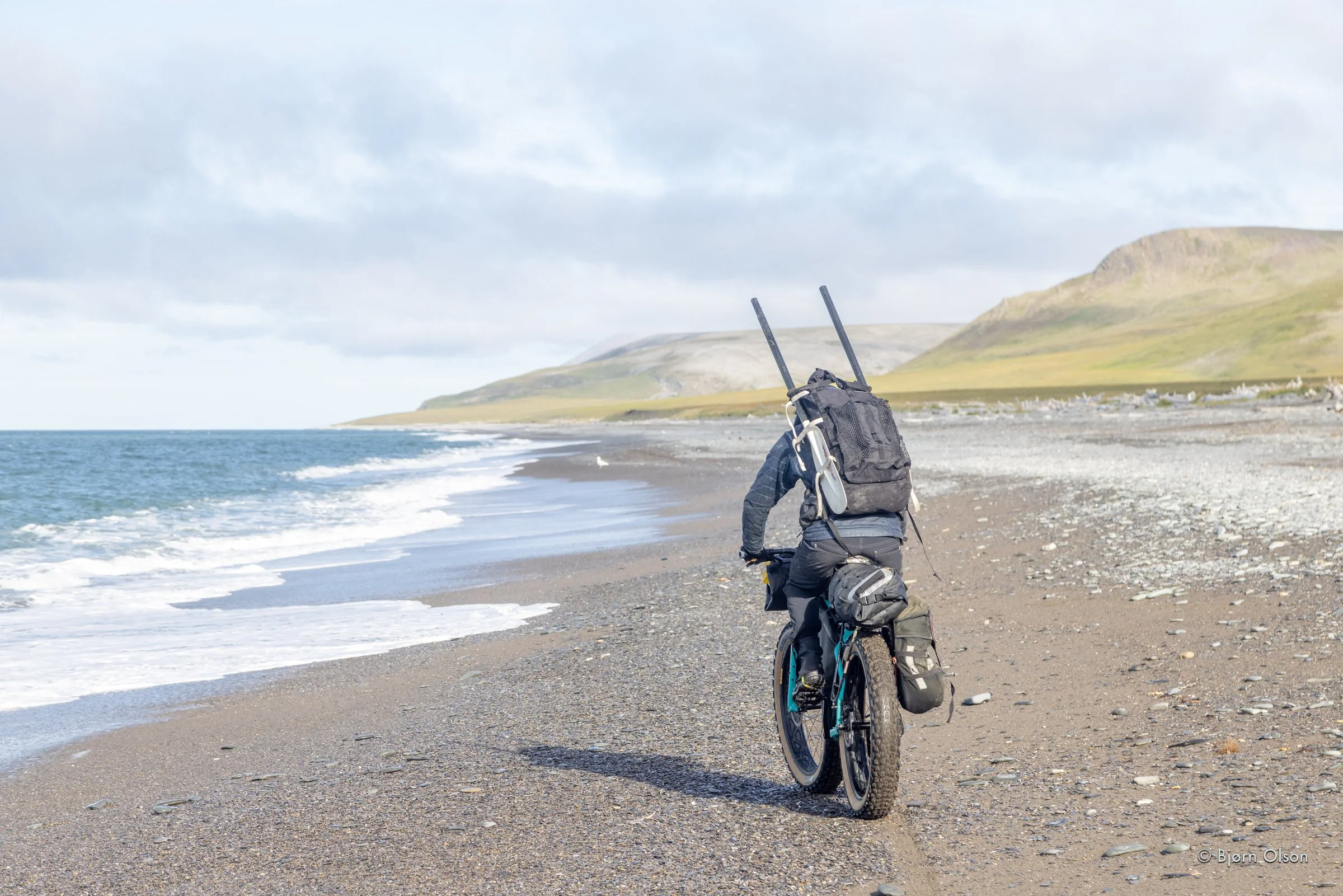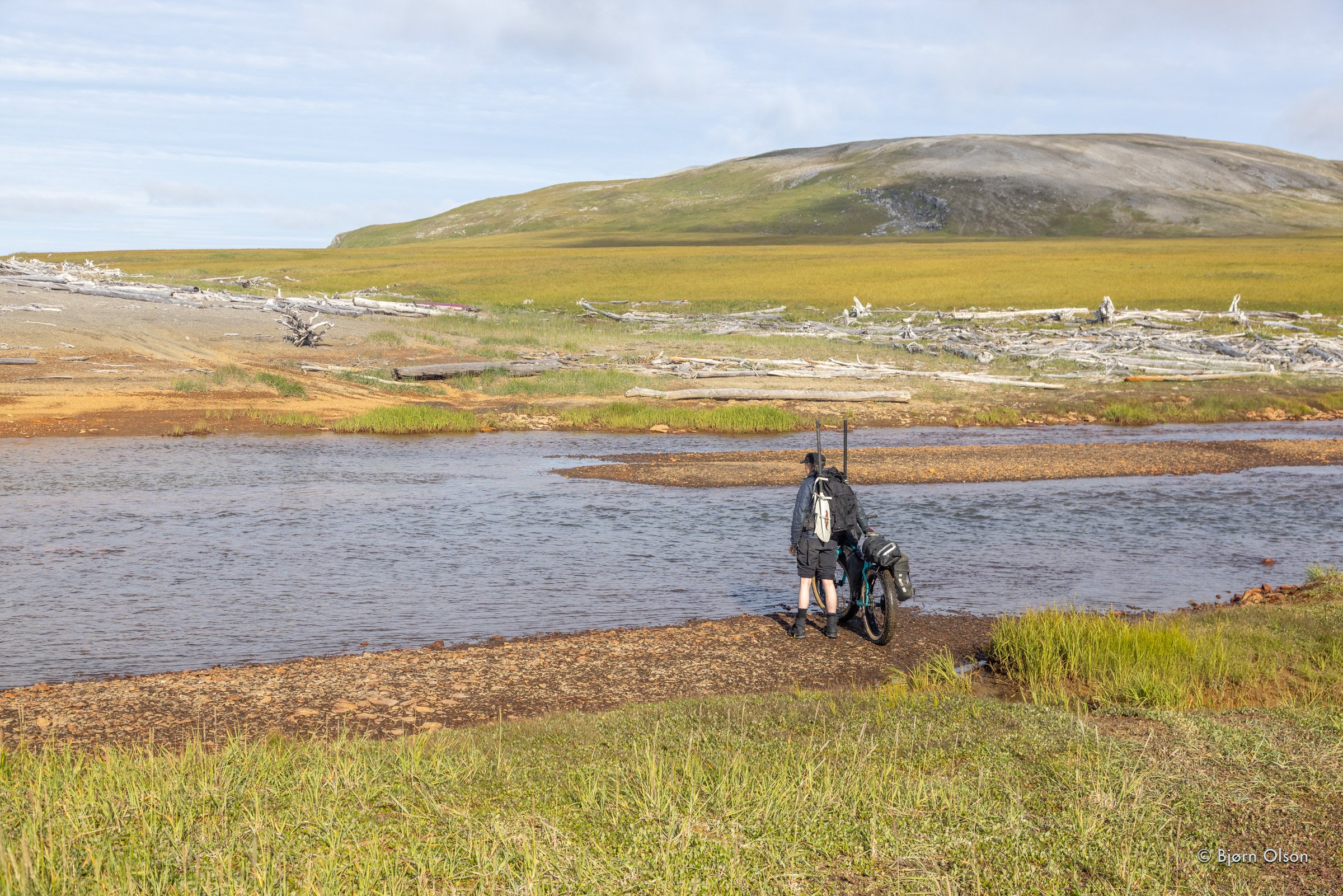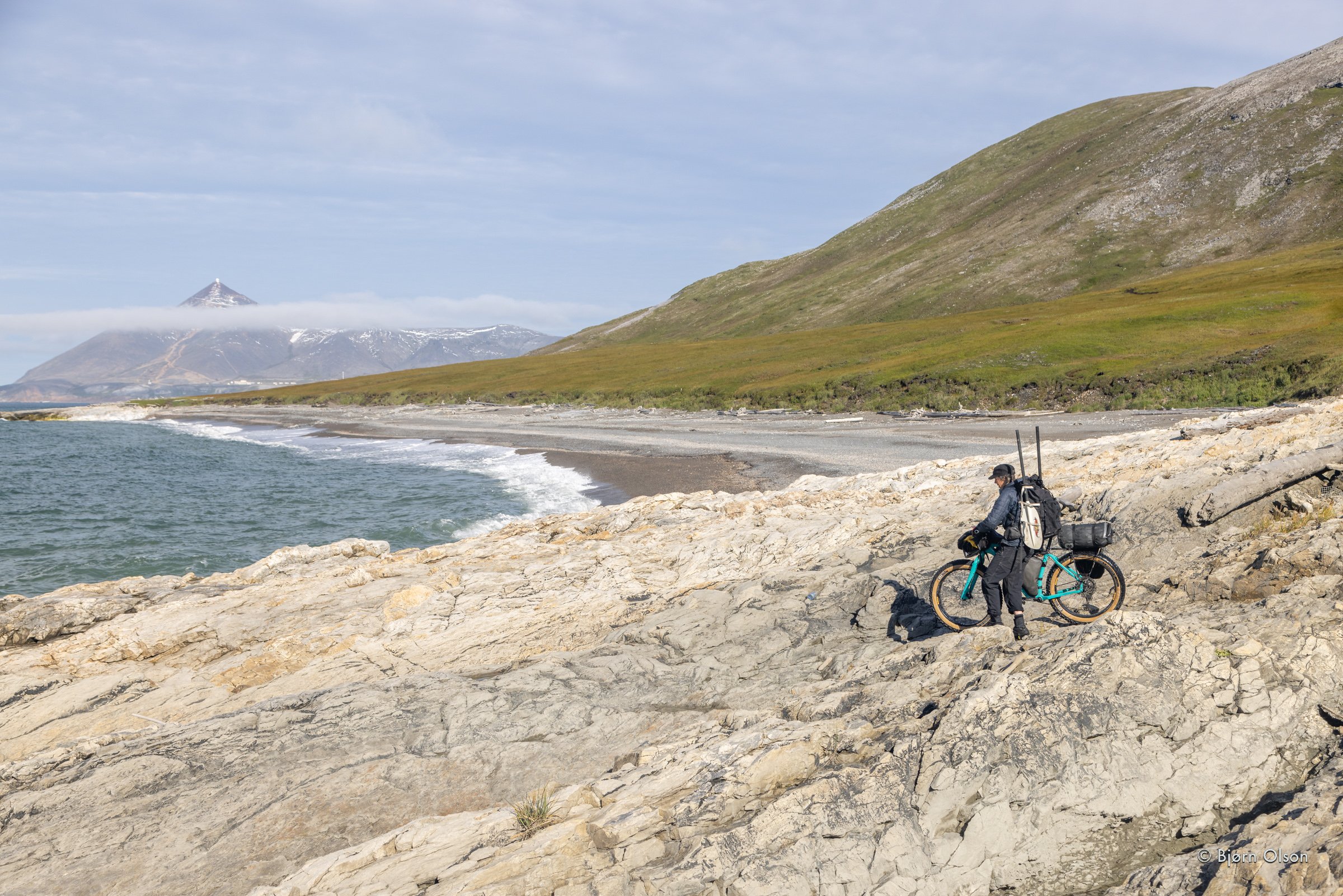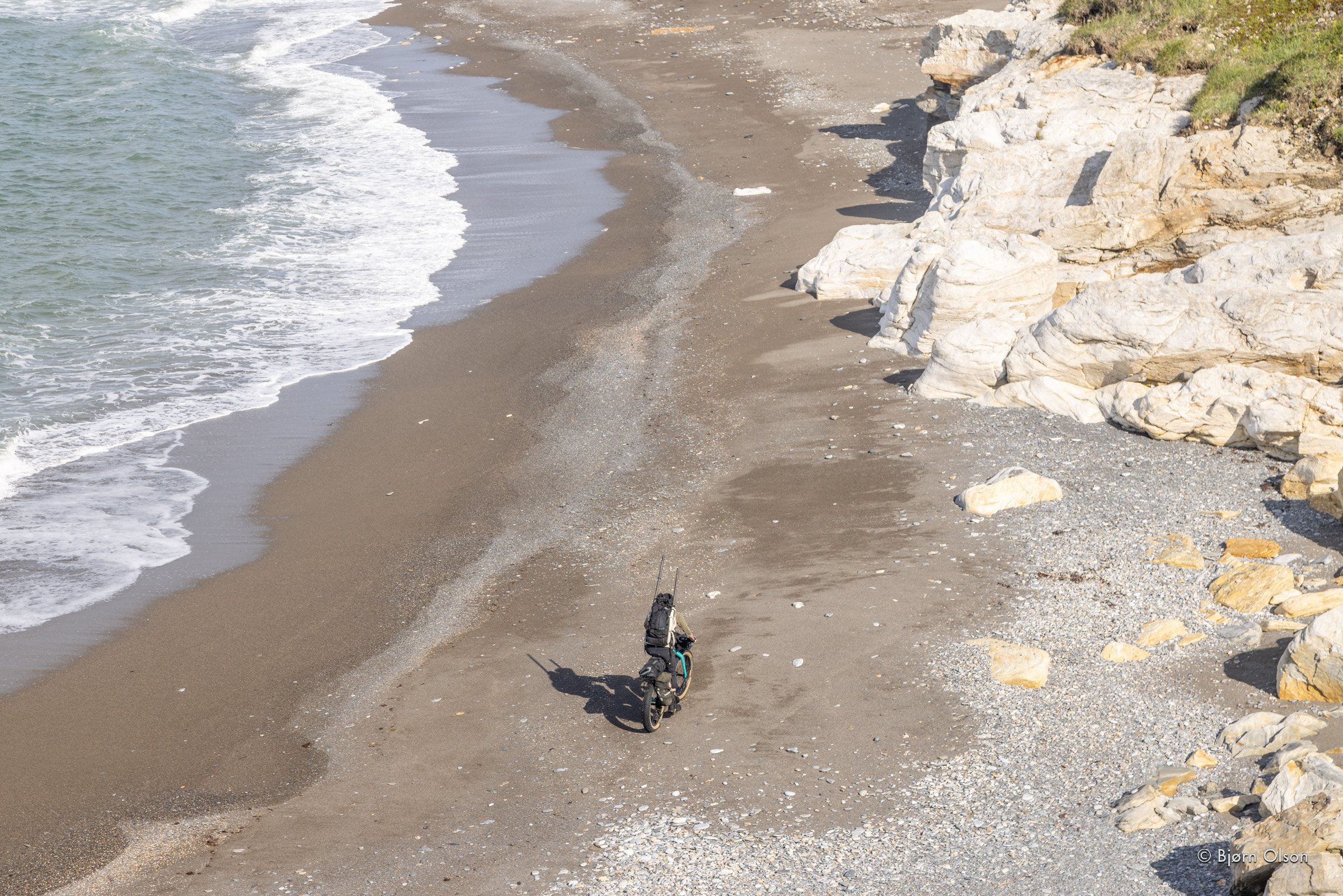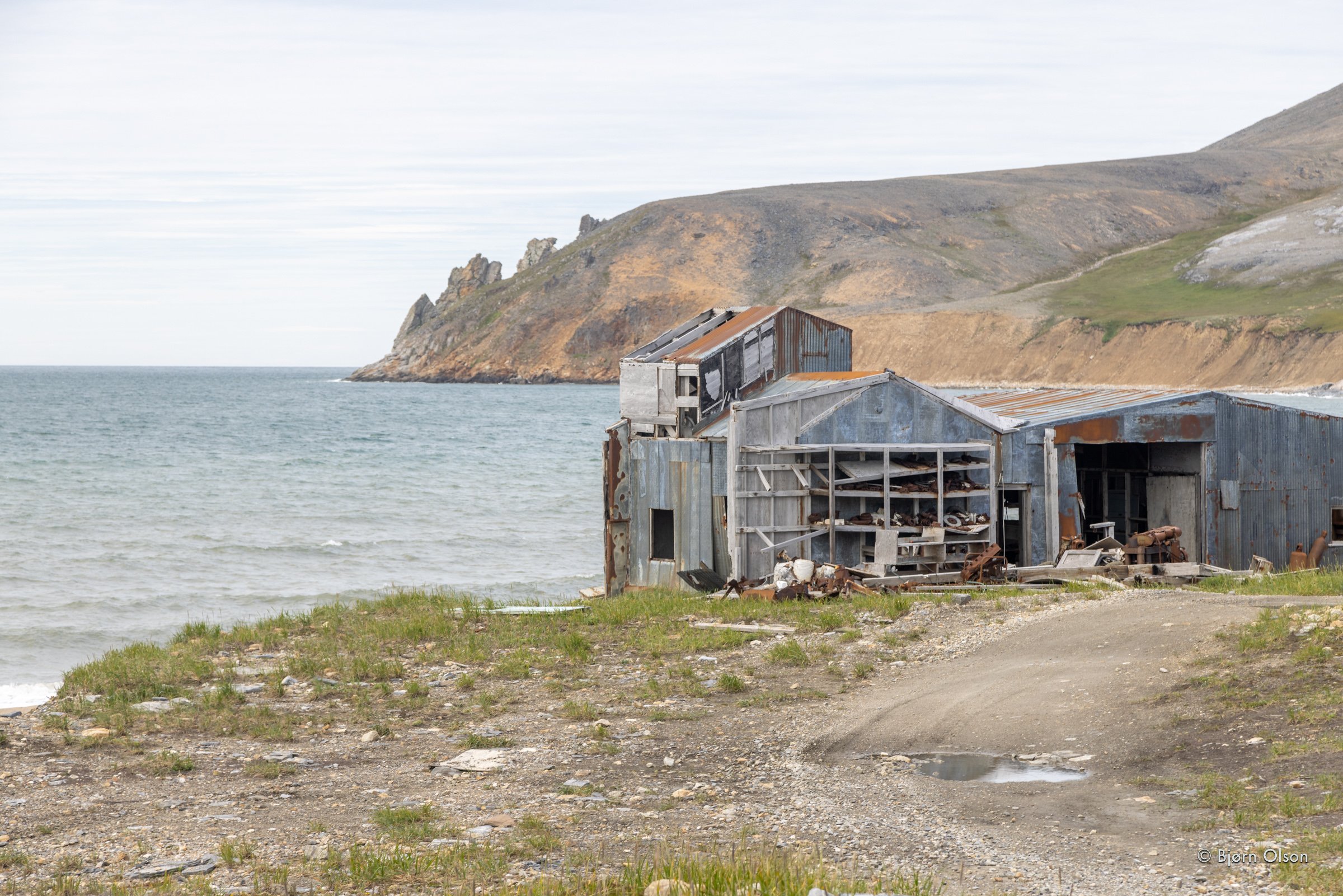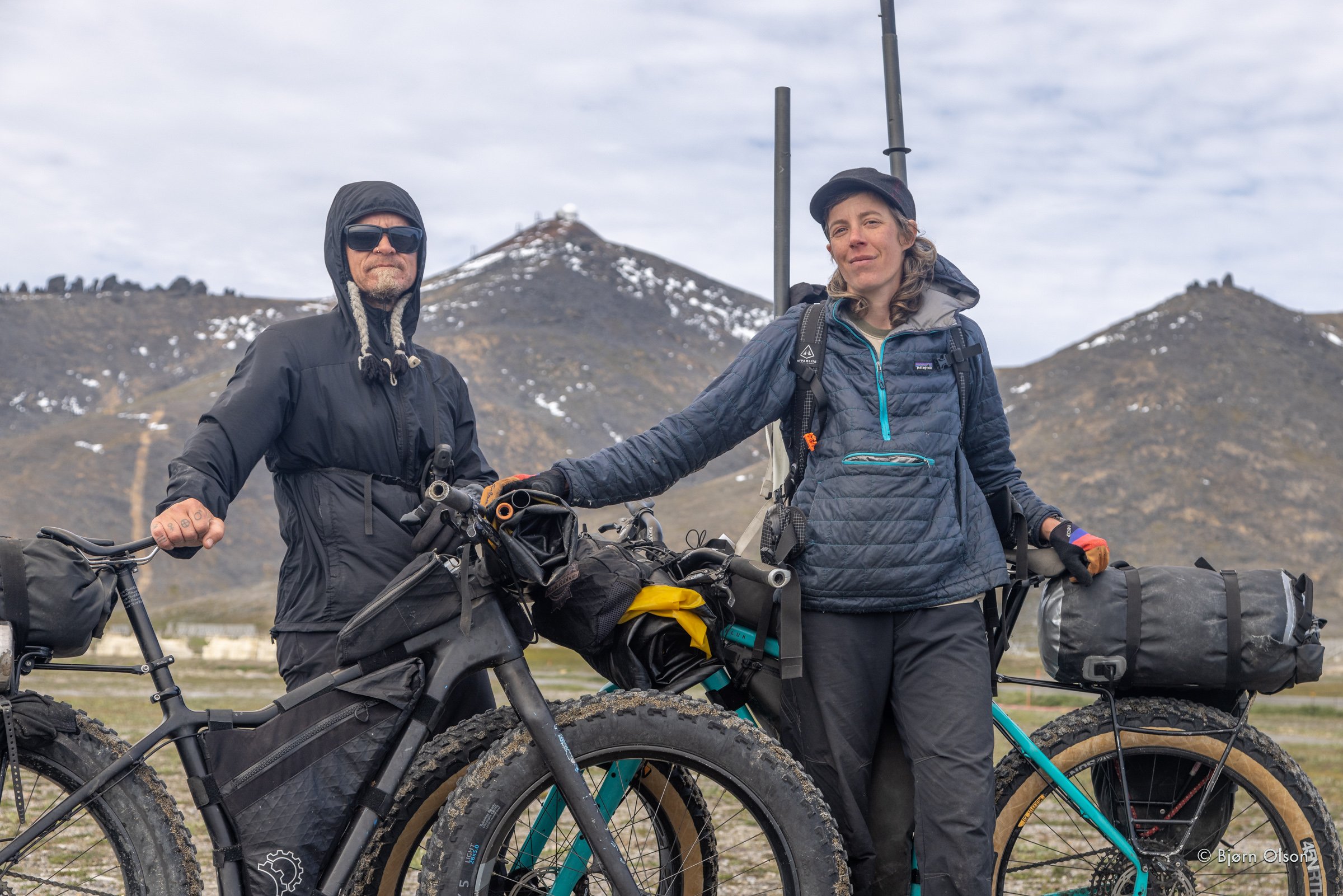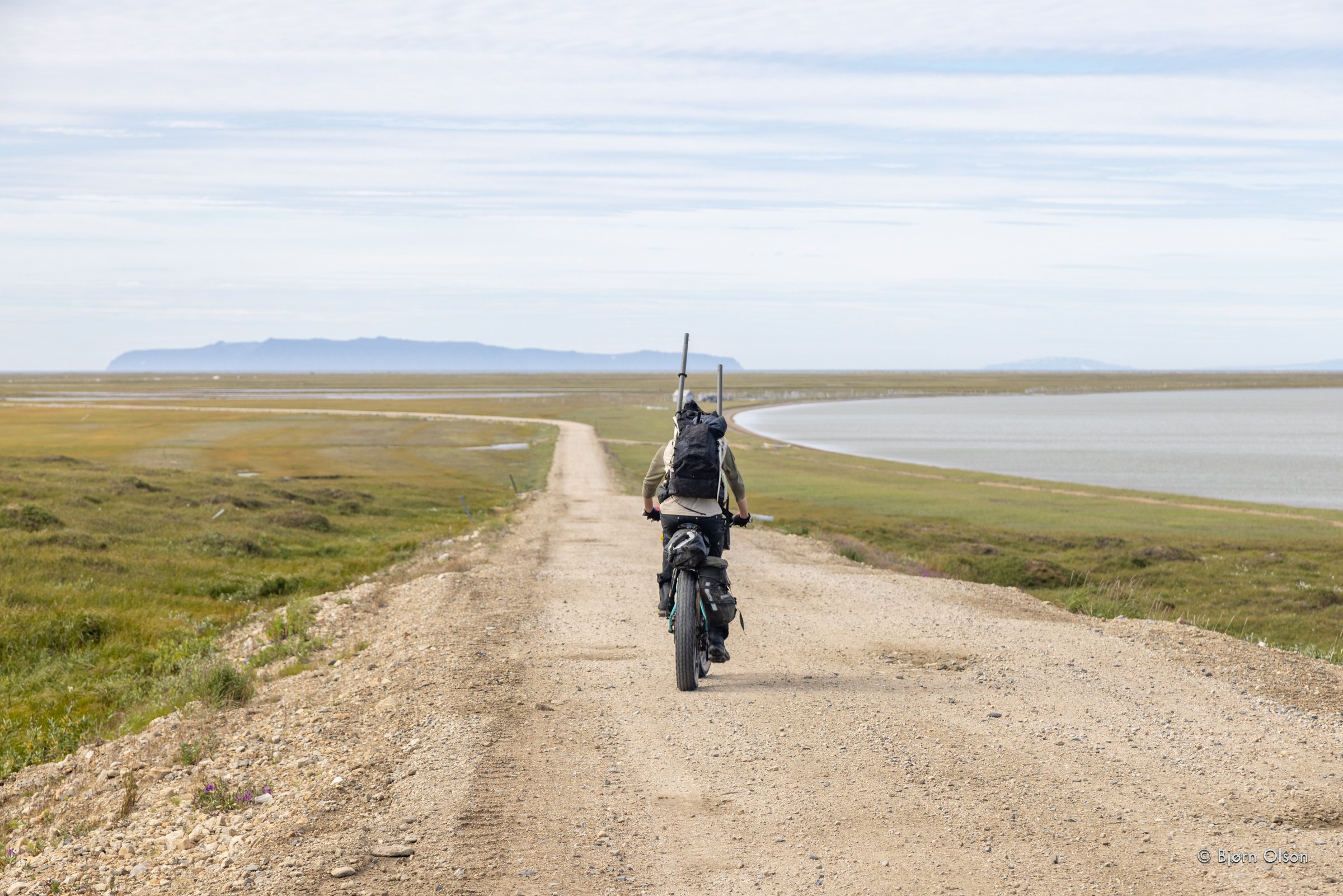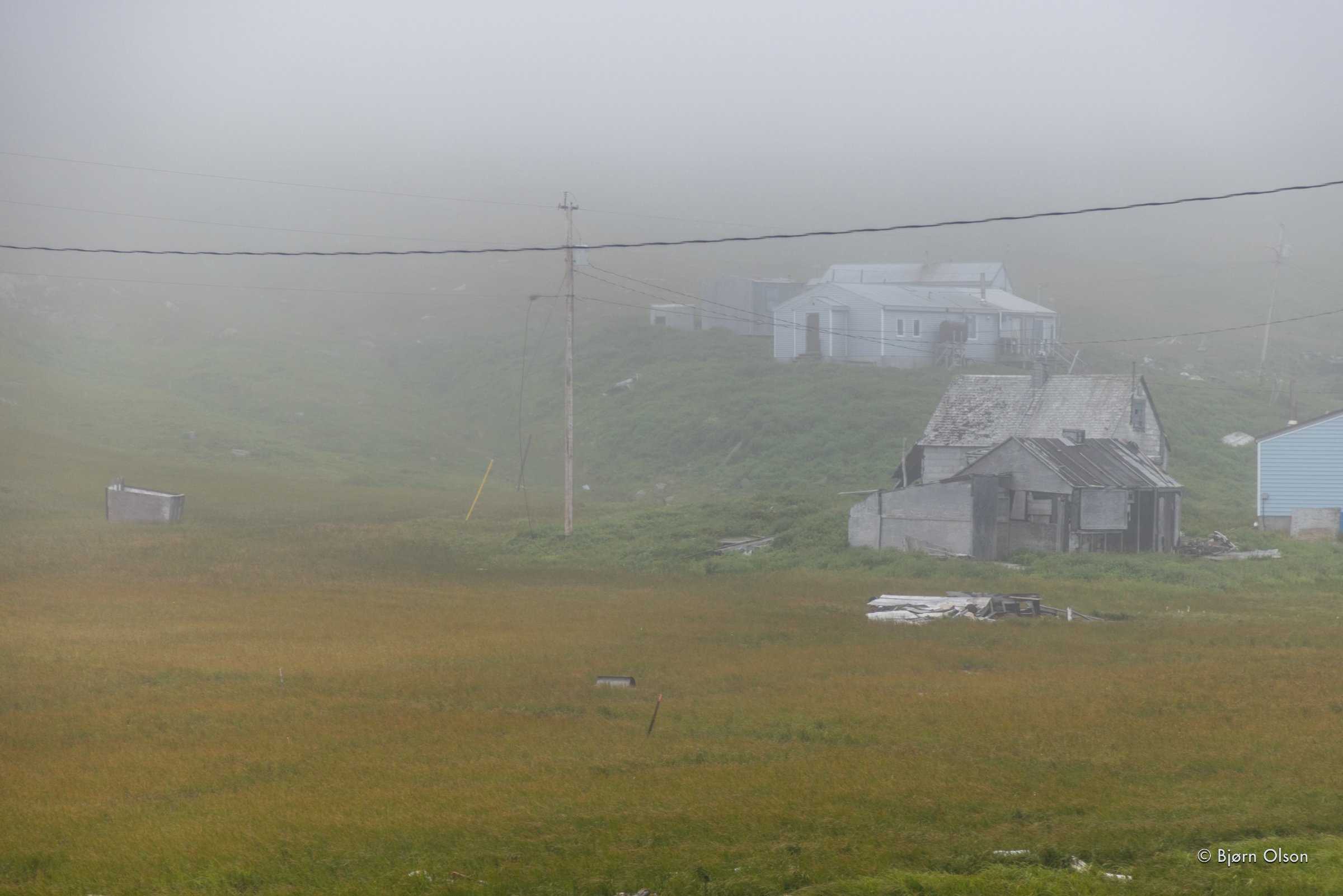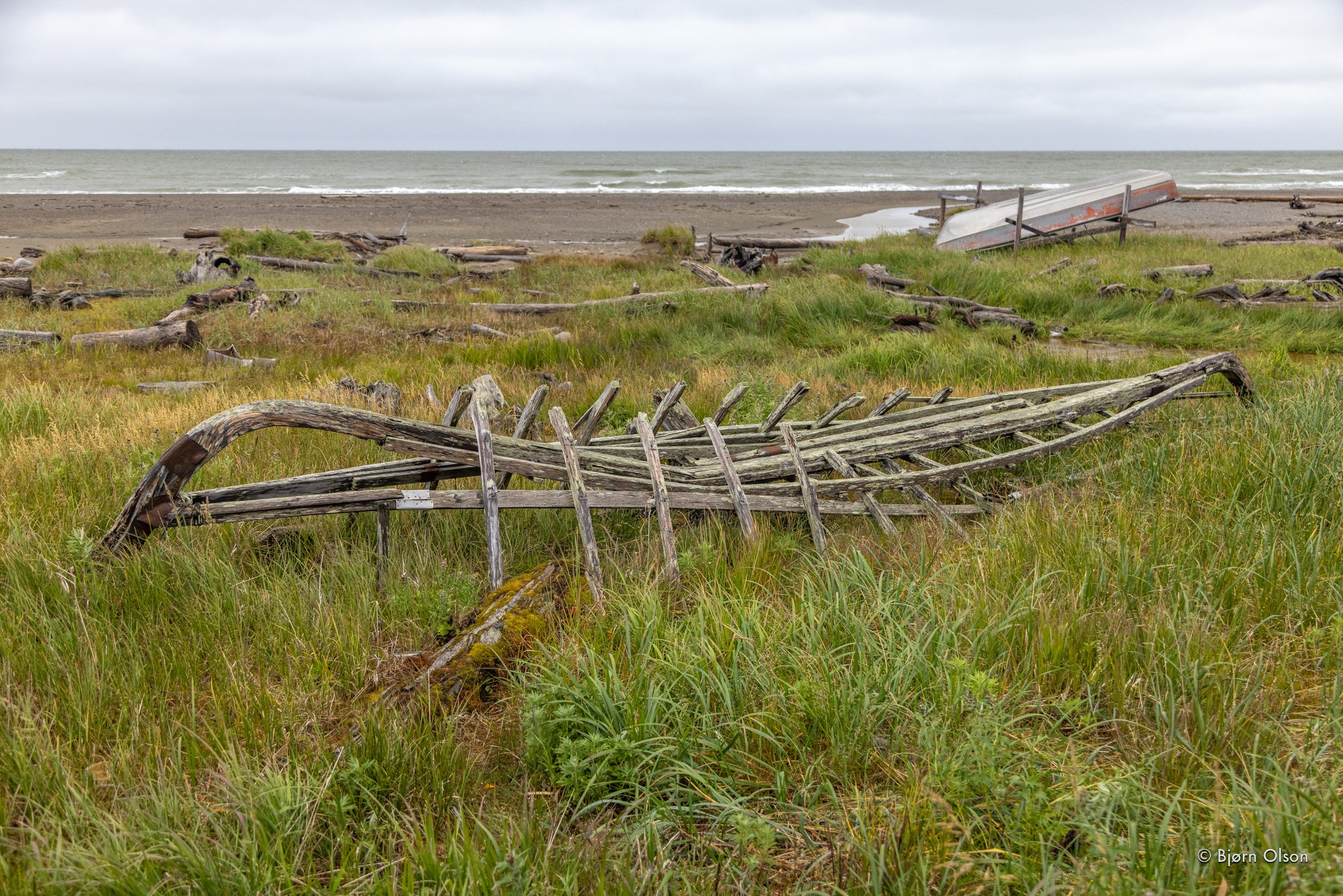Kim McNett rides her loaded fat-bike into the York Mountains of the Seward Peninsula.
In the middle of the night, on a dramatic stretch of coastline just below the Arctic Circle, the offshore gale that we had fallen asleep to suddenly switched 180 degrees. Before I fully grasped what had occurred, my hands flashed out of my toasty sleeping bag and violently grabbed ahold of our pyramid shelter that had blown over and threatened to be whisked off into the treeless mountain-scape beyond our camp. “Hold on,” I yelled to Kim over the sound of thrashing fabric. I jumped out of my bag and plunged half naked into the raging storm to re-secure the anchors. A small stuff sack whisked past my face and disappeared into the night.
A small dose of the fight or flight response is good for humans. Sprinting from a predator or charging headlong into a burning building to save a child sends a surge of survival hormones into our bodies, strengthening our wits and sharpening our ability to better respond in the future. These Ice Age adaptations are seldom necessary in our modern world of comfort, leisure, and safety. Wilderness adventures with a fat-bike into untamed landscapes provide a reliable antidote for this deficiency.
We were more than halfway through our summer fat-bike expedition, and beyond what we assumed would be the crux of our trip, when we encountered an impassable cliff face. A strong storm was blowing onto the shore, causing a storm surge, and was accompanied by six-foot waves crashing against the sliver of beach that was to be our pathway ahead. Our best option was to post up and wait for a change in wind direction to blow the conditions down. The deceitful Bering Sea had other ideas.
For over a decade, Kim and I have been returning to the windswept Seward Peninsula in the northwest of Alaska. Our first summer together as a couple, in 2009, we spent a month in the region. For the first two weeks we joined our friend, Maynard, who is a knife and ulu maker. Every summer Maynard spends several months scouring the backcountry throughout the region for shedded caribou antlers. Back home in his workshop, he upcycles the antler into knife handles. After filling his ATV trailers, Kim and I went on to explore the peninsula’s road systems and backcountry for another two weeks by fat-bike.
Since then, we have returned to the Seward Peninsula on many occasions for both winter and summer fat-bike expeditions and for work. Every trip into this sub-Arctic biome deepens our connection to the region, its culture, and people, and opens our eyes to new areas to explore.
Last June, Kim and I loaded our Subaru to capacity and drove 240 miles north from our home to the Anchorage airport. Our ambitious Nome-based agenda was on display in our compressed shocks. Packed into our car were two weeks of food, filmmaking equipment, a Rubbermaid tote full of Kim’s teaching artist supplies for our first mission: traveling by helicopter to the extremely remote community of Little Diomede to make a documentary. After flying back to Nome from Little Diomede, we would require an additional 10 days of food, fat-bikes, packrafts, backpacks, and other backcountry gear for our proposed wilderness adventure—the village of Teller to the westernmost community on the Seward Peninsula—Cape Prince of Wales. And lastly, once the 10-day fat-bike trip was over, we would return once again to Nome where I would join our knife-making friend for a 10-day caribou hunting trip.
Expensive lenses, padlocked rifle case, bike boxes stuffed beyond the 50-pound limit, and totes full of dehydrated and freeze-dried food spilled out of our car at the air cargo parking lot in Anchorage. Each of the upcoming undertakings required self-reliance. There would be no bike shops, or Amazon.Com to save us if anything was forgotten or overlooked. The piles of gear appeared absurd, but no single item that sat atop the airline’s industrial scale was superfluous.
Weeks later, with our trip to Little Diomede behind us, we biked the last miles of dirt road into the village of Teller. As the early morning sunlight penetrated our chilled bones, the familiar and carefree feeling of disconnecting from civilization washed over me. Traveling around the bend or over the next hill by human power used to be as commonplace to our species as breathing. Too much sedentism can atrophy our innate nature; my preferred antidote is to ride into wildness.
Teller, an Inupiat village of 200+ residents, is situated at the westernmost extent of the Seward Peninsula’s road-system. Shaped like a north facing arrow point, the village is hedged by water on both sides—the protected, intertidal Grantly Harbor gently laps against its eastern shore; the Bering Sea—tempestuous and unrelenting—collides with its shore to the west. It’s difficult to envision a more alluring and subsistence-rich rural community.
The familiar aroma of smokehouses packed with fresh salmon wafted through the air as we rode past chained dog teams, fishing nets, beached skiffs, fuel tanks, and the assortment of tightly spaced houses. I waved as an ATV loaded with three kids returning from the store passed us. They tepidly waved back and craned their necks at the uncommon outsiders.
Beyond the last house, the road ended. After months of planning and weeks of logistical strategizing, our off-piste excursion had finally begun. We downshifted and continued riding the remaining ¾ of a mile to the tip of the sandy spit beyond the community. At the terminus, we dismounted and began to blow up our packrafts for a short crossing. On the other side of the channel sat another small village—Brevig Mission. Beyond it, a vast and seldom visited wilderness, and, for us, the best thing a trip can provide: the unknown.
Simple yet sturdy driftwood drying racks, draped with fileted salmon, and family-group fish camps peppered the coastline for a few miles on either side of Brevig Mission. For at least 10,000 years, Alaska has been inhabited, and a lineage of traditional ecological knowledge remains unbroken throughout much of the circumpolar region. Salmon, a renewable, nutrient-dense subsistence resource, return every summer. How and when to harvest as well as how to preserve stockpiles for the long, dark winter ahead were on colorful display.
For the next two days, we strained our knees in our lowest gears and low tire pressure atop loose sand and gravel. In the distance, the York Mountains drew closer. Beach travel by fat-bikes is a straight-forward way to cover a lot of territory. Bears, foxes, caribou, and other creatures looking for the path of least resistance also use these natural pathways. Analyzing their tracks is an endless subject of inquiry. A downside to long beach routes, however, is that they can often become monotonous.
A variety of criteria are considered when we design a wilderness expedition from the comfort of our cabin. Pouring over maps and satellite images while logs radiate heat from the wood stove, we discuss options. Covering a lot of ground has appeal. Exploring interesting or exciting terrain to ride a bike on is also deeply satisfying. And, although we often repeat many of our favorite routes, we are almost always motivated to explore somewhere new.
Teller to Wales is not a particularly long route, but it met our other two criteria. Although Alaska’s population is less than 750,000, it is home to over 240 remote villages. Each is unique both in geographic location, but also culturally. Visiting these off-the-road-system communities has enriched my appreciation and understanding of this Great Land. Traveling by fat-bike, packraft or sea kayak, has afforded me countless lasting friendships that now span thousands of miles in over 80 of these often extremely remote villages and towns; saying nothing of the friendships that have been made along the trail.
Arriving in one of these communities by fat-bike is, in our experience, a remarkable ice breaker. The local hunters, who know the land best, pepper us with questions about our route, inquiring about game signs, animal migrations, or favorite landmarks. We are often bombarded by children who may be curious of any new face in town, but who show special interest in the dirty ones on funny looking, oversized bicycles. On several occasions, our good fortune has brought us into a community amid a cultural celebration. Time and time again, we have been made to feel welcome. Cape Prince of Wales, protruding into the Bering Strait, a mere 50 miles from mainland Siberia, would be new to us.
Our route also appealed to our more basic instinct: riding our bikes on giggle-inducing terrain. Between the villages of Brevig Mission and Wales sits an isolated, relatively low elevation mountain range. Full of incised canyons, dry creek and riverbeds, with compact sedimentation, and with almost no vegetation, they appeared from afar to be an ideal fat-bike, mountain-scape.
As is often the case, however, to play, we would first have to pay, and then pay again. After two days of riding the long barrier lagoon, and beaches, we reached the mouth of Lost River. From here, we would head inland and ride over and through the treeless York Mountains.
Before settling down for the evening, Kim and I admired our surroundings and peered up the Lost River canyon. If not for the cold, offshore wind, and the presence of the Bering Sea at our back, it would be easy to confuse our location for the American Southwest. New Mexico, perhaps?
Over the sound of wind ripping down the valley, we could hear approaching ATVs. Within minutes, two machines rounded the bend from the direction we had just come from. Four wide-eyed and smiling teenagers pulled up and turned their motors off. I was baffled. Along our way, we had to blow our packrafts up several times for short but deep-water crossings. “There’s a trail on the inside of the lagoon,” they informed us. “Very wet.” The mud and grass caked to their machines was all we needed to see to realize that we had divined the better, albeit semi-aquatic, path.
The Brevig Mission boys were on their way up the Lost River to visit a friend. Far into the valley a crew of seasonal workers were exploring for rare earth minerals, hoping for a motherload deposit and economic viability. Electric cars, solar panels, and other technologies have ratcheted up interest in metals mining throughout Alaska.
As someone acutely concerned about global warming and the effects it is having on our natural world, I also have misgivings about many of the proposed solutions to the crisis and the impacts they in turn will have on the environment. For thousands of years, all Alaskans lived with a different form of economy—an immediate return subsistence economy—and their impact was minimal. I often wonder if in our pursuit to prevent wholesale species extinctions and ecological collapse, are we overlooking simpler solutions? Or is our current standard of living and resource-intensive way of life too precious to barter with?
We waved goodbye to the boys, watched as they rode into the hills and began to look for a camp. With a steep hill to block the offshore wind at our back and the sea to our front, we went to sleep full of excitement. In the morning we would begin our overland ride through the mountains. The forecast was perfect.
“I admire your adventures, but I do not envy them,” is a sentiment I have heard more than once. On more than a few of our wilderness cycling trips, I have also not envied myself and I often question my judgment. Adventures by bike can be incredible; adventures with bikes can be absurd. I am not interested in dragging a bicycle through a forest of alder or up a summit just to claim a first. My passion for this activity is born from a childlike love for cycling on and over interesting terrain. Unfortunately, you don’t always get to know which one you’re choosing.
By 10 am, we were stripped down to our base layers and riding with ease on our way into the mountains. We followed a dry riverbed for several miles before turning northwest into a valley system and climbed deeper into the range. The traction was perfect. This is what fat-bikes do best.
As we continued, the massive valley we were following began branching. We took the fork we needed and continued climbing toward a high elevation pass that would deposit us into another river system that we could follow back down to the coast, but my mind was dizzy with all the possibilities. We were following a practical route through the range, but there were many other valleys and passes to explore.
As we gained elevation, small rivulets of crystal-clear pools and flowing streams began to appear. We crouched down on hands and knees and slurped our fill, submerged our sweaty foreheads, and took a break. We were engulfed in the arid and rugged mountains; in the distance a family of ptarmigan cackled.
Near the summit of the pass, we encountered a patch of loose, bowling ball-sized boulders that forced us off our bikes. For the first time since leaving the coast, we had to push. Beyond this short obstacle, we re-mounted and rode onward to the top of the divide.
At the top, we were greeted by little clumps of pale-yellow Arctic poppies that danced and swayed in the breeze. With almost no soil to cling to and situated in a spot that regularly sees hurricane force winds, we admired their tenacity, their anti-fragility. The Arctic poppy thrives under adversity. If Seneca and Marcus Aurelius did not contemplate this proud little flower, they missed an opportunity to find further confirmation for their Stoic worldview.
Our day of climbing had been a pure joy, but the lively mountains had more to give. Down, down, down we rode. Loose cobble in the steep, upper couloir required our full attention, but the grade soon slackened. The further we descended, the more compact and uniform the terrain became. For over an hour we plunged downhill until we reached a wide river valley where we turned southwest and followed the drainage back to the coast. A lone, bull caribou grazed in the distance.
Our map indicated that, once back to the shore, we would immediately confront a narrow sliver of coast with a steep and unstable slope above it. Evening light bathed the wide beach, fresh water and ample driftwood were on hand, and the day had been long. We decided to camp and save the next obstacle—the unknown—for the morning. We made a mistake.
The onshore storm built through the night and in the morning, we realized that our way forward was blocked. As winds blow onshore in the shallow Bering Sea, water levels rise into what is called a storm surge, like a high tide. The surge of water coupled with breaking waves forced us to retreat. Time and a change in wind direction would be necessary if we were to proceed along our proposed course.
Rather than consume food from our dwindling stockpile, Kim assembled our break-apart fishing pole, and we walked up the river in search of sustenance. Much to our delight, a small school of pink salmon were making their way up to their spawning grounds. None were particularly eager to bite, but with persistence we were eventually able to land four of the small but delicious salmon—our one and only meal for the day.
Two days later, we began to reevaluate our options. The sudden switch in the middle of the previous night to a violent onshore gale—powerful enough to blow our well-anchored shelter over—felt demoralizing. Two alternative options remained: pushing our bikes up and over the tall mountain, now being occupied by a grizzly, or retreating the way we had come. Both were on the table for discussion. We decided to wait one more night with the hope that conditions would finally improve. The grizzly bear, foraging a few hundred feet above us, kept us on alert and away from the fishing hole. We stoked the fire, fasted, and waited.
I sat fifty feet above Kim on a cliff face the following morning and yelled down to her. “Not yet. There’s a big set coming.” “Okay, now! Run!” The storm surge and waves had subsided, but our path forward remained menacing and dicey. As the last wave retreated, she bounded around the first of several rock outcroppings and made it to the other side. Above her, loose rocks hung precariously. We repeated this trick of timing the swell and of avoiding rockfall for the next fifteen, hair-raising minutes. Patience and luck paid off. We were finally past the constriction and back on the bikes.
Twelve miles in the distance, we could see Cape Mountain boldly thrusting into the skyline above the abandoned town and deep-water port of Tin City. An out-of-place radar dome capped its summit; a not-so-subtle reminder of the Cold War and the continued distrust of our Russian neighbors to the west.
After a painless and sunny beach ride, punctuated with a few shallow creek crossings, we arrived in Tin City in the early afternoon. Abandoned buildings from two different eras—an early mining boom, and Cold War era military installations—littered the valley. The mountains, with their ridgelines of spires and tors, looked to us like sleeping dragons. As I stopped to put on my windbreaker near a pile of rusting 55-gallon fuel drums, a plastic wrapper blew past my feet and the spell of wildness I had been under was broken.
We rode up to a pair of massive and derelict microwave towers—a pre-satellite-era communication technology—and looked back on our route. From this vantage, we could see the beach we had been stranded on for 3 nights, the York Mountains, and beyond. The view was stunning, and hard won.
Spikey outcroppings of jagged, tooth-like rocks dotted the weathered, undulating terrain along the road from Tin City to Wales. As we rounded a wide bend, the narrow waist of the Bering Strait came into view—the site of the Bering Land Bridge where the first Americans came from. Both Little and Big Diomede Islands were visible, as was the Siberian mainland—a mere fifty miles in the distance. In the middle of the strait lies the international date line. We were looking both into tomorrow, and into the deep past.
As we drew closer to the village, a familiar sound came from overhead. A twin-engine Bering Air passenger airplane was on its approach. It turned into the stiffening wind and landed on the long, gravel airstrip. “Think we can catch it before it takes off?” I asked Kim. “It’s worth a shot.” The headwind was working against us, but we shifted into high gear and began racing the last miles into town.
Over the years, we have learned to make peace with the often-schizophrenic nature of wilderness adventures in the far north. When conditions are good, we have learned to strike and to strike hard. We have also had to learn to be patient; to ration, to fast; to remember that nature is supreme; often cruel and unforgiving to those who act with hubris. Adventures, we have found, come not from what you expect, but rather from what you didn’t expect.
As we sped to catch the plane, I began to feel conflicted. Had being stranded for three-days made us impatient to be done? Were we hurrying to miss an opportunity, an experience? A half mile from the airstrip my concern vanished. Fate took over as we watched the plane taxi down the runway and take off back to Nome. Little did we realize that Mother Nature and her trixie vixen, the Bering Sea, weren’t finished with us yet. A fresh storm was brewing, and that was to be the last plane into Wales for the next four days.

